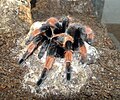America and Panama: Pamphobeteus antinous Pocock, 1903 – Peru, Bolivia Pamphobeteus augusti (Simon, 1889) – Ecuador Pamphobeteus crassifemur Bertani,...
6 KB (530 words) - 00:32, 15 February 2024
Pamphobeteus antinous, also known as the Bolivian blue leg bird eater or steely blue leg, was first described by Reginald Innes Pocock in 1903. It is found...
3 KB (268 words) - 14:56, 27 September 2023
it to the new genus Pamphobeteus, and designated it as the genus's type species. Wikimedia Commons has media related to Pamphobeteus nigricolor. Rogério...
1 KB (96 words) - 15:54, 9 December 2023
Pamphobeteus fortis also known as the Colombian giant copperhead or Colombian giant brown tarantula is a tarantula which was first described by Anton Ausserer...
2 KB (163 words) - 01:41, 9 July 2022
Pamphobeteus vespertinus also known as the Ecuadorian red bloom tarantula is a tarantula first described in 1889 in Eugène Simon. They are found in the...
2 KB (240 words) - 00:36, 23 August 2024
"Adventurers Amusement Park". A large species of tarantula from Ecuador, Pamphobeteus nellieblyae Sherwood et al., 2022, was named in her honour by arachnologists...
50 KB (4,788 words) - 08:43, 15 August 2024
Ozopactus Simon, 1889 – Venezuela Pachistopelma Pocock, 1901 – Brazil Pamphobeteus Pocock, 1901 – South America, Panama Parvicarina Galleti-Lima, Hamilton...
63 KB (6,921 words) - 20:54, 3 August 2024
List of Theraphosidae species (section Pamphobeteus)
Brazil Pamphobeteus Pocock, 1901 Pamphobeteus antinous Pocock, 1903 - Peru, Bolivia Pamphobeteus augusti (Simon, 1889) - Ecuador Pamphobeteus crassifemur...
124 KB (7,275 words) - 02:35, 24 July 2024
described by Reginald Innes Pocock in 1901. They look similar to members of Pamphobeteus except for its legs; the third and fourth pairs of legs are much larger...
3 KB (159 words) - 17:37, 1 March 2024






